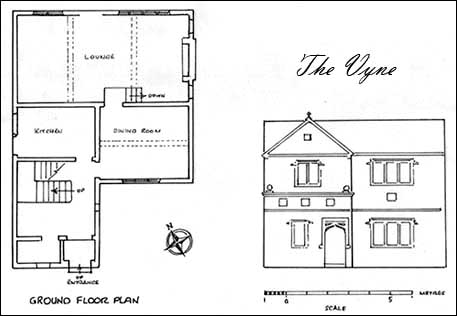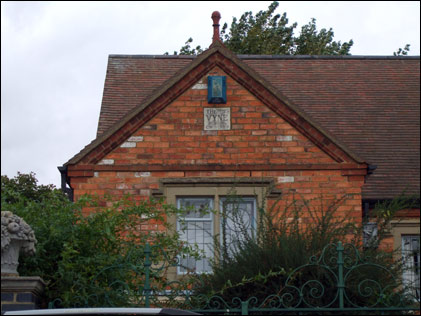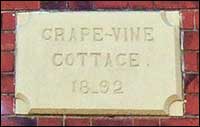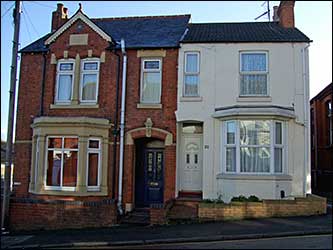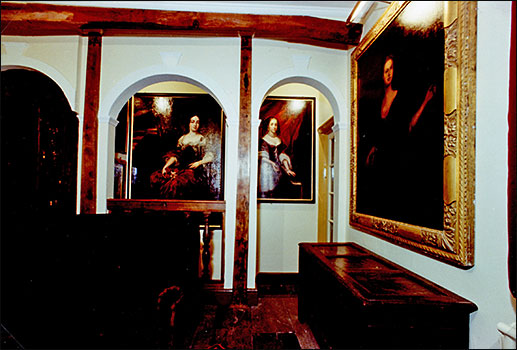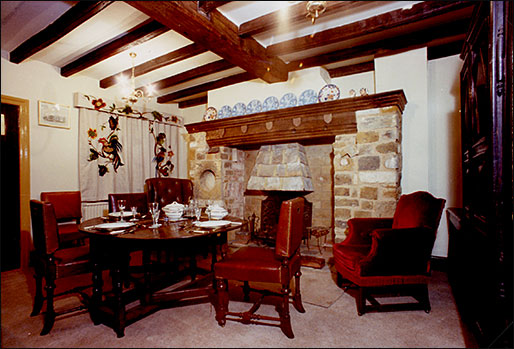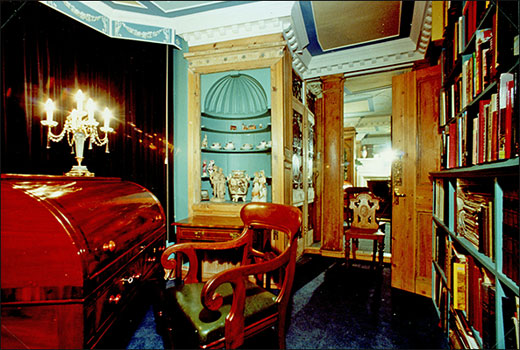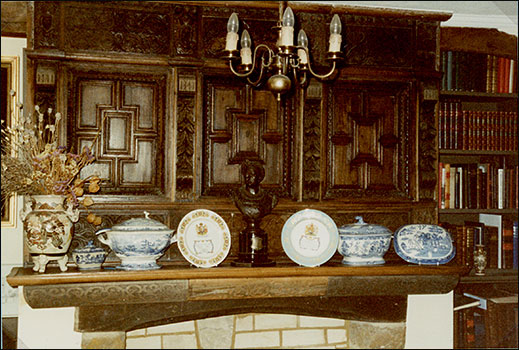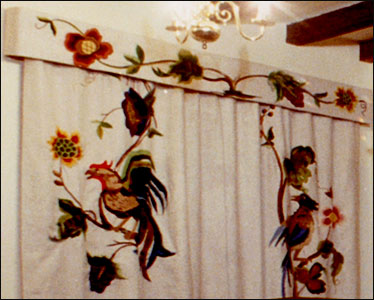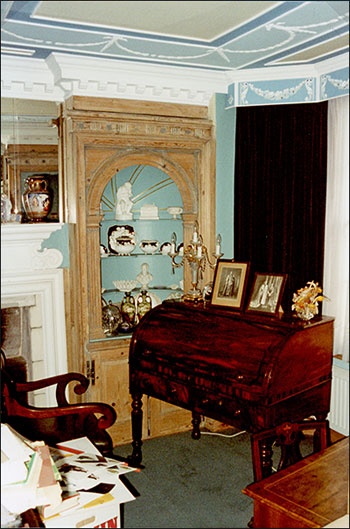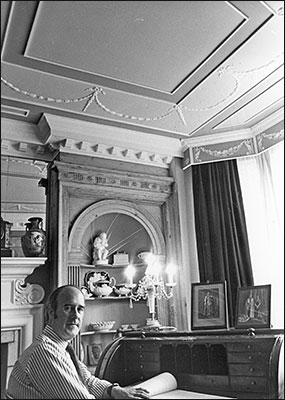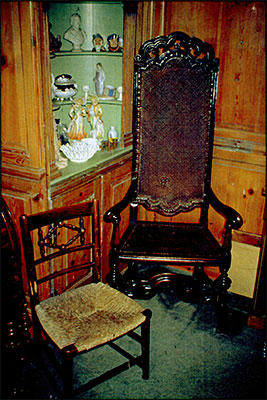|
|||||||||||||||||||||||||
| October 9th 2009, Clive Wood |
|||||||||||||||||||||||||
|
'One Man's Castle' - The Vyne
|
|||||||||||||||||||||||||
|
Building 22 Woodland Road & 82 Washbrook Road 'Wentworth Cottage'
|
|||||||||||||||||||||||||
|
|||||||||||||||||||||||||
|
I have often thought I should make a record of my home. 'The Vyne' and its contents may be of limited interest but from my own point of view would be one way of still enjoying my collection if I start or indeed am able to dispose of the contents of my home. As the date indicates these were my thoughts nearly twelve months ago and it has taken until a week ago, August 27 2010, to make any moves, having asked a representative from Charles Ross, Fine Art Auctioneers, to call and give me some idea as to what might sell or not! Evan Willis, Manager of the saleroom, called and was most encouraging. I get to a point where I would like to retain just a few pieces - but which? Indeed what is saleable? I suppose everything has a price albeit probably less than I might think, though most of my collection was bought or acquired at reasonable, not to say cheap prices. I have titled my scribblings as 'One Man's Castle' though Graham Wise said everyman should build 'his Cathedral' — either way I did embark on the creation of a house, originally for Mum and me. I was a bit stupid and really never thought very hard about what I was creating, did we need a 'largish' house or was it just my whim!, I enjoyed doing 'Fitzwilliam House', 82 Washbrook Road, which was a conversion — 22 was a 'new build'; no doubt if Graham Wise had not been available to do the plans I wouldn't have embarked on the project; there was no way I would have paid £1000 for the services of an architect which was a price I was given. One can't go back in time and it has been an interesting exercise but now I think I've had enough and would like a little money (should be some left after paying off Harpenden Building Society but a bit of an unknown area). Would like 250k clear but might be disappointed. The house itself is not everybody's 'cup of tea' but as Mike Neville said when selling '22', "we're looking for someone as eccentric as you" — who knows there must be someone out there who would like something 'a bit different!' I'm always telling other people to write down their memories; the written word is the most enduring; now I had better practice what I preach! |
|||||||||||||||||||||||||
I think it should also be said that the seed was sown having converted 82 Washbrook Road into a mixture of styles, not at all relevant to a late Victorian Terrace House, that are its origins. I suppose any scheme of conversion is governed by what materials you have, the 1960-70s were a period of destruction, when to destroy almost any property in the name of progress was seen as a good thing and the concept of re-use or to give it the modern term re-cycling was not often considered. Demolition of the day was to clear the site, burn all the wood and anything else combustible, bury the brick, stone etc. or use it as hardcore. There were demolition companies like Heath & Hawkes of Finedon or just 'one man and his machine' outfits, among the latter Ken Impey of Higham Ferrers and Ivan Hamilton of Rothwell; both were excellent contacts to have, both were very approachable and were in no way greedy, it was quite easy to have materials for the asking or sometimes use '20 Players' cigarettes as currency. This activity occasionally worked, even with large contractors, but in Northampton's wholesale destruction for re-development probably made contractors keen to clear their sites quicker rather than for a profit. On the site of Newland, originally an elegant street of Georgian properties, I obtained an entire room of eighteenth century panelling including a superb shell cupboard, a wing chair and the front door surround, for 20 Players. These items were installed at 82 Washbrook Road and with the exception of the door surround, moved to The Vyne in due course. 82 Washbrook which I called 'Wentworth Cottage' from its connection on the deeds as part of the Fitzwilliam Estate, which included a prohibition to make bricks and tiles, the Fitzwilliam Estate being in the Peterborough area intended to keep its monopoly on such manufacture there. With '82' the initial thought of conversion was to divide the house vertically; Georgian front and Jacobean rear, a very loose guide, there were no plans, just a few items to give a 'period' feeling. After some major alterations I acquired a full set of Oak joists from Gold Street, Wellingborough, excellent 'principal room' quality with bevelled and beaded edges, approximately six feet long they needed a main beam to support them, this we acquired but not sure from where, but together they needed a thirteen foot room to put them in, we decided to demolish the middle wall between rear and front rooms, of course we needed to support the wall above, between the two bedrooms and obtained a suitable steel girder from Marriott's, with assistance from their workforce installing it on two 14inch piers and building a new stud partition giving the required 13ft room space. Having also removed the passage to the front door and the wall of the staircase, a pair of pine double doors from the waiting room of Raunds Railway Station were put in between the new larger lounge and reduced front room, the doors were given by John Shrives who with his parents and family lived in the old station, running a Commercial Vehicle business, John was a very good customer for a number of years. The doors typical of their age and quality were primed in red lead and resisted all attempts to 'burn off' for re-painting. Having removed the staircase wall the exposed string of the original stairs was subsequently covered with 17th century oak from Rushden Hall and other places, the hand rail, balusters and newel post from the small staircase, also from the Hall, balusters about 1600 and a particularly pretty newel post, always sorry I had to leave it. On the first floor the landing was incorporated into the old middle bedroom and again balusters from the Hall within an arch installed as a room divider between stairwell and what was planned as a first floor sitting room.
Since we have now ascended the stairs, we incorporated three long, slightly curved beams under the existing ceiling - these were acquired from old pigsties at the rear of The Nunnery, Rothwell (via Ivan Hamilton) and despite their length, were brought home on the roof rack of my A30 van; the one closest to the chimney breast was used to fix the Jacobean overmantel from Goldington Bury and incorporated simple cupboards at each end. A window seat was put in the left hand recess from Parson's Cottage, Irchester, and was the one that we had found a number of coins underneath, pushed through a crack in the top, no coins of great value but back to the 1600's. The fireplace was built by Dad from Wellingborough stone including two stone brackets from a first floor fireplace in Gold Street - quite a nice detail, the lintel of the opening incorporated a shield shaped keystone from a Washbrook Road house, demolished and rebuilt next to the Oakley pub, a wide Oak shelf was put on top but not sure from where. The overmantel with quite an attractive example of applied decoration and carved panels of strapwork of about 1600, was part of a complete panelled room from Goldington Bury sold by the Inskip family. I purchased it from Don Sherwood for £15. I could have had the complete room for £75 but couldn't afford it. The overmantel originally had four carved figures on it, I assume in the style of the carved heads which remain, but these were removed before Don acquired it and we covered the vacant spaces with four carved pieces of fruit and leaves, Victorian pieces from old furniture that Brian and I found in the garden of the 'Pink House' at Earls Barton and look quite well.
The 'Pink House' was the former home of Mrs Campbell-Caven, widow of a slipper manufacturer of Wellingborough. Brian and I were acting as porters at the 'Sale of Contents' which Swindall, Pendered & Atkins were selling off. We 'rescued' quite a number of pieces from the garden where various items of furniture had been abandoned by their owner, Mrs Campbell-Caven, who was said to be rather excentric and reputed to have kept a lion in the house. She had originally lived in a large and beautiful house on the Earls Barton/Northampton Road corner and it was said she built her final home - the 'Pink' property to mar the view she had enjoyed from her original home.
Whilst in the upstairs lounge we might as well complete the description - this room and the ground floor Dining Room were both lit by three panel lead light windows, the centre panel opening, attractive design of small diamonds between longer pieces with shaped 'saddle bars', curved tops, originally first floor windows from Oxford Street, Wellingborough, demolished for road widening. In the opposite corner of the Lounge a small Oak plank door (where the landing wardrobe used to be), gives access to the attic, reached by a small staircase made by Gramp, not sure where the door came from but I think in area of the Vets, Sheep Street, Wellingborough.
Having just discovered some photographs taken by John from number 78 Washbrook Road, most of what I have written seems about right!
February 5th 2010 To continue we move into the front room and continue in the 'Georgian' period, sort of 1750's, this room had two shell cupboards in it, the one next to the fireplace over a small cupboard all part of the same structure, this 'shell' made with thin sheets of Oak divided by flat beadings with overlough edging into five sections finished in a shell pattern, the whole design rising from a semi-circular shape at its base, it had been enclosed by a pair of doors, possibly glazed, originally painted a Turquoise Blue, some of which remains, highlighted with Gold Leaf, in its position on the ground floor at Northampton it appeared to have been separated from the first floor panelled room which had been painted the same colour though the later had been repainted many times ending up in Cream. On the opposite side of the room adjacent to the front door I put a second shell cupboard, this one from Parson's shop in Duck Street, a totally different construction, the shell formed like a chocolate orange from thirty five segments of various sizes, very attractive from the front but like so many antique pieces very rough on the reverse, held together with rabbit glue and blacksmith's nails. This was one of my first acquisitions from Ken Impey, demolition contractor; I had always wanted a shell cupboard and to get two I always thought was very lucky, they are not that common. |
|||||||||||||||||||||||||
|
October 31st 2020 - continuation of 'No 82' It has been eleven years since I wrote down my activities in my first house - 82 Washbrook Road - having started to record the alterations to the property I seem to have stopped after four pages - if I did write any more I seem to have lost it, not surprising with my general disorganisation - particularly where paper is concerned. I will now try to complete my records and memories of 'Wentworth Cottage', not easy after nearly forty years but here goes. It was a bit difficult to do the work when my father - the bricklayer, and my grandfather - the carpenter, were at loggerheads. Both were excellent craftsmen but regrettably were not speaking to one another and had not done so for many years, proving rather awkward when you needed them both to work on the same property - Dad was still at work at Colworth House, the Unilever establishment, and Gramp only worked on the house during the day when dad was away. It is difficult after so many years to remember how on earth we worked it! However we did. I don't think Gramp and Dad ever really did get on and perhaps that was why Mum and Dad moved to Biggleswade soon after they were married, thereby denying me the opportunity to say I am 'born and bred' in Rushden as by birth I am a 'Bedfordshire Clanger'! There is really no way I can remember the sequence of work in the house and can only remember various work carried out individually rather than in order. I have already recorded a number of major alterations, I can but add other changes as I recall them, I think the only way is room by room, starting from the back door - opposite that was the door to the pantry under the stairs - we had removed the wall of the living room, creating a recess with stone floor and a new wall at right angles to the original door - creating a smaller pantry. I had acquired a small switch from Woburn Abbey (courtesy of Mr Roly Smith) which switched the pantry light on as you opened the door, into the new piece of wall, which dad built, we incorporated a sixteenth century stone mullion from the north wing of Rushden Hall. The open area we created under the stairs was large enough to accommodate the large sideboard from Aunt Ede, a Mahogany piece of two cupboards with a drawer above and a drawer between, a decorative back to it, on short fluted legs and other decoration, circa 1820, rescued from Herbert Pentlow when it was on its way to the tip! The stairs had been reduced by the two bottom steps I think and Dad built two steps with stone and slabs from the Hall, one a winder as a feature, I put a small barrier to turn you into the room, made from two seventeenth century turned banisters and a handrail supported by an equally old joist, the two barley twist banisters came from the small staircase to the Cock Loft in Rushden Hall. I was very fortunate when last year the current owner enquired about the 'work' in the house and I was able to give her some pictures and details, she in return gave me the two banisters which she had removed, lovely to have them again, a chance to strip them of the terrible black stain with which the Victorians had covered all the antique woodwork in the Hall. Whilst in the Dining Room the fireplace should be noted, changed from the original 'domestic' fireplace of a late Victorian terraced house to a large open 'inglenook' type fireplace, first supporting the original chimney breast, Dad then installed an open hearth with a hood of Collyweston tiles (from Weldon), a cast iron fireback (repro) was installed with firebasket and 'dogs'. Some rather nice stone was used to build the piers on either side to support the overmantel beam, not an original, but a cut down seventeenth century main beam from Lymington House, Higham Ferrers, that would have been used to support a principal room ceiling; there were still five of the original joist holes which I covered with cut-out Oak shields. I did start to carve one end of the beam but abandoned the idea. The top of the fireplace was finished off by a 4"-5" wide moulding in old Oak by Woodwards. As already said the stone was of good quality, a mixture of lime and ironstone from Gold Street, Wellingborough, except, on the left two pieces of stone forming a circular surround, originally for a ventilator in a farm building at the Nunnery, Rothwell. Due to the very bold moulding on the overmantel beam Dad had to set the top of the piers back to align the face of the beam with the face of the piers To the right of the fireplace, a small lead light window in the dividing wall between the Dining room and front room, this is one of the widows from the Manor House in Duck Street, demolished in the 1930's and rescued by Uncle Ted - it had stood in Gramps garden (No 18) ever since. Returning to the front room, I suppose you could call it a study since it has a complete wall of book shelves - shelving from a butchers shop in Finedon or Irthlingborough - not sure who from but it was good shelving at the right price! Having already mentioned the Shell cupboards, the fireplace surround though 'classic' is not as old as it should be, about 1850 while the Duck's Nest Fireplace, though damaged is - about 1750, from Parson’s Cottage, Irchester. at the opposite end of the room, a floor to ceiling mirror (2 pieces) from a Jeweller’s Shop in the Arcade, Northampton, flanked by shallow pine pilasters I think from Inkerman Terrace, Northampton. The ceiling painted in 'Adam' colours, surrounded by a wooden cornice with wooden brackets, which I cut, all from the Northampton house, some Lincrusta decoration and the pelmet painted to compliment the ceiling. We should perhaps now look at the Kitchen which I have difficulty in remembering, obviously entering, turning right at the back door the one thing to remember is the pump, serviced from a rainwater sump in the yard and should have provided a good supply of 'soft' water, unfortunately I couldn't get it to draw but the cast lead spout made an attractive feature. Not sure where the hot water boiler was, I assume next to the sink, with the cooker on the opposite wall. I wanted to break through to the coal barn, which was for a time my workshop, we went through what was the kitchen fireplace, intending to convert the barn to the bathroom. At the opposite end we did fix at eye level a unit of sixteen small drawers from Gramp's workshop - a bit rough but looked well when they were painted up, a lot of the walls were tiled and on the right I included the panel of poppies from Norfolk which went after I sold the house. When I first bought the house I used the barn as a workshop installing an angled bench on the opposite wall from the kitchen, using it for a number of years before building a new workshop, attached to the house, the outside toilet which was in the corner of the barn we retained. There used to be a tin (corrugated iron) shed, painted brown, which we took down and replaced with a new brick built workshop about 12' x 8', which Dad must have done, reused doors and window and a pantile roof. The end wall looking up the garden had a level parapet with the two balls on it, one from the Hall and one from Newnham Priory, the door way was framed with fluted pilasters from the Northampton house in Newland. Eventually Dad built a wall, linked to the workshop wall, to form a gateway for the 'Police' gate, not sure whether it was the Inspector’s or Sergeant's, and included a pierced ecclesiastical stone grill I had from Mr John Slee. Having now entered the back garden I will record what I can remember though some details are rather vague. I do remember that it was absolutely overgrown with Teasles; I have a photograph somewhere. There were two structures I can remember, the open hovel is still there but a large shed of wooden uprights with a corrugated roof has gone, put up purely to cover a Tip Cart I bought in a weak moment from Rod Warner! What did I want a Tip Cart for? It was in a fair condition but needed re-painting which I would have enjoyed; it had a nice panel on the front showing it came from Ely, but needless to say I had no where to put it when we built '22', so it was put in one of Russell Hodson’s barns at Raunds through the good offices of Pete Skinner; whether it still exists I have no idea, hopefully somebody may have restored it. Later I did work in the barn sign writing Russell's lorry or something? At the top of the garden Dad built me an open front Hovel with a pantile roof, perhaps 6' x 12', the end facing the house was built in Flemish Bond, with red Rushden brick stretchers and Cambridge white headers this was done to enclose the date stone of Blousic Dairy, thereby matching its original appearance in that building, having failed to buy the house - (outbid by Sanders the builders) I had at least been given the date stone. An armorial piece with the Arms of Charles Cecil Mitchell, J.P. (a Scottish family) who had built the house in 1862, originally called the Cottage, though it was really a farm Mr. Mitchell seems not to have enjoyed his house for long, Mr. F. U. Sartoris had been in residence when it was sold in 1888. On the other side of the garden I buried Pete, a Welsh Collie cross, which upset me to such an extent I have never had a dog since. There are one or two extra details to mention, the barn that I had used as a workshop for a time became the bathroom, we installed a Mid-brown bath and washbasin, presumably concreting the floor and tiling the walls as necessary, the recess behind the outside toilet was fitted as a shower with a ceramic tray, far better than the present 'plastic' type. Gent’s provided and fitted a patterned plate glass door which they sent away to have it toughened - I think? The washbasin had a 'push button plug', I was very pleased with the end result but don't think I used the bath much and the shower never! It’s difficult to remember where I had got to with '82' when I started Woodland Road. I had a new front wall built, Dad had already built a new wall in front of '80' not sure when but he then did one for me, three piers and 4½" wall, two recessed panels, piers with a tiled crease and edgeway brick tops, these consist of bricks cut to always show a complete face and not the 'holes' which are usual in modern new bricks. John Gay of Marriott’s commented on how long Dad took to do the wall but he couldn't fault the workmanship. A standard 'run of the mill' wrought iron gate was installed. The front porch was enclosed by Gramp, converting an inside 'four panel' door into one with two small glazed panels at the top, these were filled by leadlights, of an oval design. The name 'Wentworth Cottage' signwritten on the top rail. The back bedroom was reduced by putting a toilet and washbasin in the first section, a reused four panel door was used, which on the inside I papered with old newspapers, one reporting Sqd. Leader Orlebar winning the Schneider Trophy, (pity I had to leave it!). A new window had to be installed and a large mirror behind the wash basin, I seem to think there was a large hot water cylinder installed somewhere in the area. The rest of the bedroom was left and used for storing other things! |
|||||||||||||||||||||||||
|
|
|||||||||||||||||||||||||
